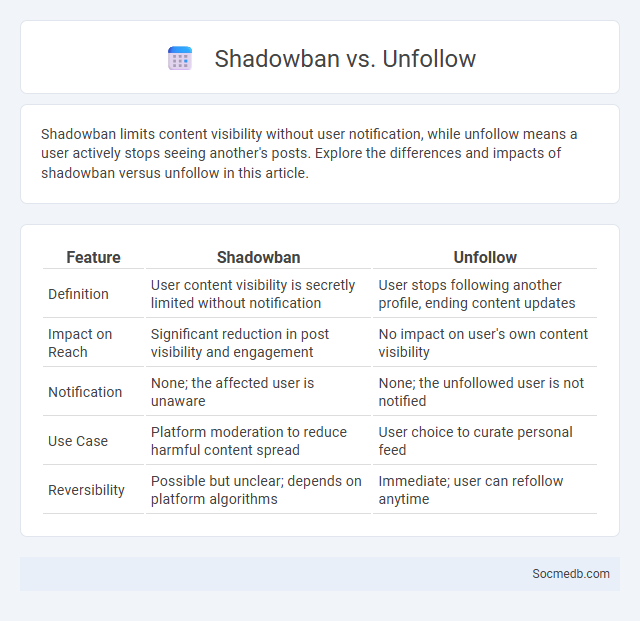
Photo illustration: Shadowban vs Unfollow
Shadowban limits content visibility without user notification, while unfollow means a user actively stops seeing another's posts. Explore the differences and impacts of shadowban versus unfollow in this article.
Table of Comparison
| Feature | Shadowban | Unfollow |
|---|---|---|
| Definition | User content visibility is secretly limited without notification | User stops following another profile, ending content updates |
| Impact on Reach | Significant reduction in post visibility and engagement | No impact on user's own content visibility |
| Notification | None; the affected user is unaware | None; the unfollowed user is not notified |
| Use Case | Platform moderation to reduce harmful content spread | User choice to curate personal feed |
| Reversibility | Possible but unclear; depends on platform algorithms | Immediate; user can refollow anytime |
Introduction: Understanding Shadowban and Unfollow
Shadowban limits the visibility of your social media posts without notifying you, reducing reach and engagement significantly. Unfollow refers to users intentionally or unintentionally removing you from their follower list, impacting your follower count and social proof. Understanding these concepts helps you navigate social media algorithms and maintain your online presence effectively.
What is a Shadowban?
A shadowban restricts your social media content visibility without notifying you, causing your posts to appear less frequently in feeds or search results. This hidden limitation impacts your engagement by reducing the reach of your hashtags, comments, or entire account, often due to algorithmic detection of spammy or inappropriate behavior. Understanding shadowbans helps you adjust your content strategy to maintain authentic interactions and prevent diminished audience growth.
Signs You’ve Been Shadowbanned
Your social media reach may suddenly plummet due to shadowbanning, a hidden moderation practice that restricts content visibility without notification. Common signs include a dramatic decline in engagement metrics such as likes, comments, and shares, coupled with the absence of your posts in relevant hashtags or follower feeds. Monitoring these indicators can help you detect if the platform's algorithm has limited your account's exposure, allowing you to adjust your content strategy accordingly.
What Does Unfollow Mean on Social Media?
Unfollow on social media means stopping the receipt of updates or posts from a particular user without removing them as a friend or follower. This action customizes the user's feed, allowing them to control the content they see and reduce unwanted posts. Platforms like Instagram, Twitter, and Facebook offer this feature to enhance user experience by filtering content without causing social friction.
How Shadowban Differs from Unfollow
Shadowban limits the visibility of your social media content without notifying you, causing your posts to disappear from hashtags and follower feeds, while an unfollow simply means a user has chosen to stop seeing your content in their feed. Unlike unfollowing, which is a deliberate action by another user, a shadowban is an algorithmic restriction imposed by the platform due to perceived violations or spam-like behavior. Understanding this distinction helps you better manage your social media presence and identify why your engagement might suddenly drop.
Shadowban vs Unfollow: Impact on Engagement
Shadowban on social media restricts content visibility without user notification, leading to significant drops in engagement metrics like likes, comments, and shares due to reduced organic reach. Unfollow by users results in a direct loss of audience and engagement but does not affect the content's distribution or discoverability for other followers. Understanding these differences is crucial for optimizing strategies to maintain follower interaction and content performance on platforms like Instagram, Twitter, and TikTok.
Reasons Why Users Get Shadowbanned
Users often get shadowbanned on social media due to repeated violations of community guidelines, such as posting inappropriate content or engaging in spamming behaviors. Algorithms detect suspicious activities like excessive commenting, using banned hashtags, or rapid follow-unfollow actions, which can trigger restrictions. Understanding these triggers helps you avoid shadowbans and maintain your account's visibility and engagement.
How to Detect and Recover from a Shadowban
Detecting a shadowban on social media involves monitoring sudden drops in engagement, such as reduced likes, comments, and follower growth, despite consistent content quality. You can confirm a shadowban by checking if your posts fail to appear in hashtag searches or on followers' feeds using incognito modes or different accounts. Recovery strategies include pausing posts for a few days, reviewing and removing any content or hashtags that violate platform guidelines, and gradually rebuilding your account activity with compliant, engaging content.
Preventing Shadowban and Managing Unfollows
Preventing shadowban on social media requires consistent adherence to platform guidelines, avoiding spam-like behavior, and using relevant hashtags strategically. Monitoring follower activity regularly helps identify potential mass unfollows, enabling timely engagement with your audience through authentic content and direct interaction. Employing analytics tools to track account visibility and follower retention ensures proactive management of shadowban risks and follower churn.
Conclusion: Shadowban vs Unfollow—Key Takeaways
Shadowban limits a user's content visibility without notification, significantly reducing audience reach and engagement on platforms like Instagram and Twitter. Unfollow directly impacts follower count, signaling reduced interest or dissatisfaction but does not restrict content exposure to others. Understanding the differences helps users and marketers better navigate engagement strategies and maintain authentic growth.
 socmedb.com
socmedb.com